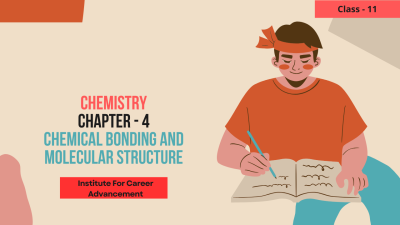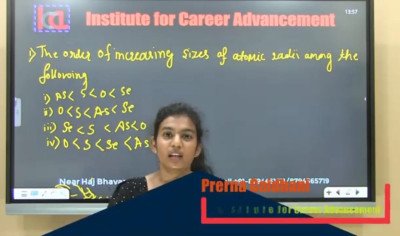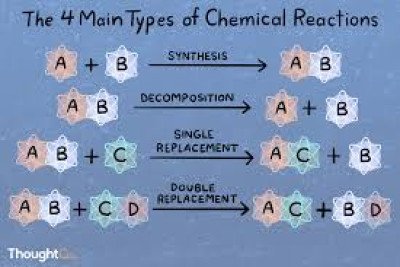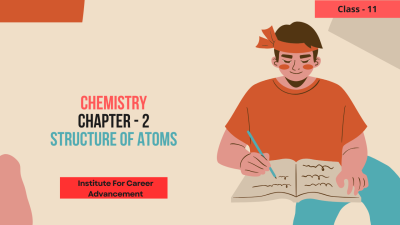Course description
Chemical reactions are often portrayed as a one-way street – reactants transform into products, and that's it. But in Equilibrium (Class 11), you'll discover a fascinating truth: chemical reactions are more like a dynamic dance! Get ready to explore the concept of equilibrium, where opposing forces come together to create a balanced state.
Beyond the One-Way Street:
We'll begin by dismantling the misconception that reactions proceed only in one direction. You'll learn how many reactions are actually reversible, meaning they can occur in both the forward and reverse direction simultaneously.
The Balancing Act of Equilibrium:
Now comes the magic! Imagine a state where the forward and reverse reactions in a closed system happen at exactly the same rate. This is chemical equilibrium. At this point, the concentrations of reactants and products become constant, creating a seemingly static state.
Equilibrium: A Balancing Act, Not a Standstill:
Don't be fooled by the constant concentrations! Equilibrium is a dynamic state. The opposing reactions continue to occur, but at equal rates, resulting in no net change in concentrations. It's like a perfectly balanced seesaw – both sides exert equal force, maintaining a stable position.
Shifting the Balance: External Influences:
Imagine a gentle push on the seesaw! External factors like temperature, pressure, and concentration can influence the position of equilibrium, causing it to shift in a specific direction to re-establish balance. You'll explore how these factors affect the equilibrium constant, a key value that defines the equilibrium state for a particular reaction.
Le Chatelier's Guiding Principle:
Navigating the world of equilibrium changes can be tricky. But fear not! Le Chatelier's principle comes to the rescue. This powerful tool predicts how a system at equilibrium will respond to changes in these external factors. By understanding Le Chatelier's principle, you'll be able to predict how the equilibrium position will shift to counteract the imposed change and maintain balance.
Beyond the Course:
Depending on your specific curriculum, you might delve deeper into:
- Applications of equilibrium principles in various chemical systems (e.g., solubility equilibria, acid-base equilibria).
- Quantitative aspects of equilibrium – using the equilibrium constant (Kc) to calculate concentrations of reactants and products at equilibrium.
রাসায়নিক বিক্রিয়াগুলিকে প্রায়শই একমুখী পথ হিসাবে চিত্রিত করা হয়-বিক্রিয়করা পণ্যগুলিতে রূপান্তরিত হয়, এবং এটিই। কিন্তু ইকুইলিব্রিয়ামে (ক্লাস 11) আপনি একটি আকর্ষণীয় সত্য আবিষ্কার করবেনঃ রাসায়নিক বিক্রিয়া অনেকটা গতিশীল নাচের মতো! ভারসাম্যের ধারণাটি অন্বেষণ করার জন্য প্রস্তুত হন, যেখানে বিরোধী শক্তিগুলি একত্রিত হয়ে একটি ভারসাম্যপূর্ণ অবস্থা তৈরি করে।
ওয়ান-ওয়ে স্ট্রিটের বাইরেঃ
আমরা এই ভুল ধারণাটি দূর করে শুরু করব যে প্রতিক্রিয়াগুলি কেবল একটি দিকেই এগিয়ে যায়। আপনি শিখবেন যে প্রকৃতপক্ষে কতগুলি প্রতিক্রিয়া বিপরীতমুখী, যার অর্থ এগুলি একই সাথে সামনের এবং বিপরীত উভয় দিকেই ঘটতে পারে।
ভারসাম্য আইনঃ
এখন জাদু আসছে! এমন একটি অবস্থা কল্পনা করুন যেখানে একটি বদ্ধ ব্যবস্থায় সামনের এবং বিপরীত প্রতিক্রিয়া ঠিক একই হারে ঘটে। এটি রাসায়নিক ভারসাম্য। এই মুহুর্তে, প্রতিক্রিয়াশীল এবং পণ্যগুলির ঘনত্ব স্থির হয়ে যায়, যা আপাতদৃষ্টিতে স্থির অবস্থা তৈরি করে।
সামঞ্জস্যঃ একটি ভারসাম্য আইন, স্থবির নয়ঃ
ক্রমাগত ঘনত্ব দ্বারা বোকা বানাবেন না! ভারসাম্য একটি গতিশীল অবস্থা। বিপরীত প্রতিক্রিয়াগুলি ঘটতে থাকে, কিন্তু সমান হারে, যার ফলে ঘনত্বের কোনও নিট পরিবর্তন হয় না। এটি একটি নিখুঁত ভারসাম্যপূর্ণ সিজারের মতো-উভয় পক্ষই একটি স্থিতিশীল অবস্থান বজায় রেখে সমান শক্তি প্রয়োগ করে।
ভারসাম্য পরিবর্তনঃ বাহ্যিক প্রভাবঃ
কল্পনা করুন সিজার উপর একটি মৃদু ধাক্কা! তাপমাত্রা, চাপ এবং ঘনত্বের মতো বাহ্যিক কারণগুলি ভারসাম্যের অবস্থানকে প্রভাবিত করতে পারে, যার ফলে এটি ভারসাম্য পুনরুদ্ধারের জন্য একটি নির্দিষ্ট দিকে সরে যেতে পারে। আপনি অনুসন্ধান করবেন কিভাবে এই কারণগুলি ভারসাম্য ধ্রুবককে প্রভাবিত করে, একটি মূল মান যা একটি নির্দিষ্ট বিক্রিয়ার জন্য ভারসাম্য অবস্থাকে সংজ্ঞায়িত করে।
লে চ্যাটেলিয়ারের পথনির্দেশক নীতিঃ
ভারসাম্য পরিবর্তনের জগতে চলাচল করা কঠিন হতে পারে। কিন্তু ভয় পাবেন না! লে চ্যাটেলিয়ারের নীতিটি উদ্ধার করতে আসে। এই শক্তিশালী সরঞ্জামটি ভবিষ্যদ্বাণী করে যে ভারসাম্যপূর্ণ একটি ব্যবস্থা এই বাহ্যিক কারণগুলির পরিবর্তনের প্রতি কীভাবে প্রতিক্রিয়া জানাবে। লে চ্যাটেলিয়ারের নীতি বোঝার মাধ্যমে, আপনি ভবিষ্যদ্বাণী করতে সক্ষম হবেন যে আরোপিত পরিবর্তনকে প্রতিহত করতে এবং ভারসাম্য বজায় রাখতে ভারসাম্যের অবস্থান কীভাবে পরিবর্তিত হবে।
কোর্সের বাইরেঃ
আপনার নির্দিষ্ট পাঠ্যক্রমের উপর নির্ভর করে, আপনি আরও গভীরভাবে অনুসন্ধান করতে পারেনঃ
বিভিন্ন রাসায়নিক ব্যবস্থায় ভারসাম্য নীতির প্রয়োগ (e.g., solubility equilibria, acid-base equilibria).
সাম্যাবস্থার পরিমাণগত দিক-সাম্যাবস্থায় প্রতিক্রিয়াশীল এবং পণ্যগুলির ঘনত্ব গণনা করতে সাম্যাবস্থার ধ্রুবক (Kc) ব্যবহার করে।



















